Layer I Interneurons Sharpen Sensory Maps during Neonatal Development
- PMID: 29937280
- PMCID: PMC6152945
- DOI: 10.1016/j.neuron.2018.06.002
Layer I Interneurons Sharpen Sensory Maps during Neonatal Development
Abstract
The neonatal mammal faces an array of sensory stimuli when diverse neuronal types have yet to form sensory maps. How these inputs interact with intrinsic neuronal activity to facilitate circuit assembly is not well understood. By using longitudinal calcium imaging in unanesthetized mouse pups, we show that layer I (LI) interneurons, delineated by co-expression of the 5HT3a serotonin receptor (5HT3aR) and reelin (Re), display spontaneous calcium transients with the highest degree of synchrony among cell types present in the superficial barrel cortex at postnatal day 6 (P6). 5HT3aR Re interneurons are activated by whisker stimulation during this period, and sensory deprivation induces decorrelation of their activity. Moreover, attenuation of thalamic inputs through knockdown of NMDA receptors (NMDARs) in these interneurons results in expansion of whisker responses, aberrant barrel map formation, and deficits in whisker-dependent behavior. These results indicate that recruitment of specific interneuron types during development is critical for adult somatosensory function. VIDEO ABSTRACT.
Keywords: barrel cortex; calcium imaging; development; interneuron; layer I; spontaneous activity; thalamocortical connectivity.
Copyright © 2018 Elsevier Inc. All rights reserved.
Conflict of interest statement
Figures

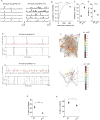
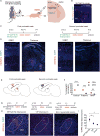
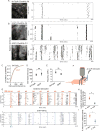

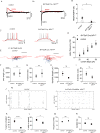

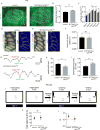
Similar articles
-
Recruitment of GABAergic Interneurons in the Barrel Cortex during Active Tactile Behavior.Neuron. 2019 Oct 23;104(2):412-427.e4. doi: 10.1016/j.neuron.2019.07.027. Epub 2019 Aug 26. Neuron. 2019. PMID: 31466734 Free PMC article.
-
NMDA receptor-dependent pattern transfer from afferents to postsynaptic cells and dendritic differentiation in the barrel cortex.Mol Cell Neurosci. 2002 Nov;21(3):477-92. doi: 10.1006/mcne.2002.1195. Mol Cell Neurosci. 2002. PMID: 12498788 Free PMC article.
-
Reelin restricts dendritic growth of interneurons in the neocortex.Development. 2021 Sep 1;148(17):dev199718. doi: 10.1242/dev.199718. Epub 2021 Sep 6. Development. 2021. PMID: 34414407 Free PMC article.
-
Neuronal activity is required for the development of specific cortical interneuron subtypes.Nature. 2011 Apr 21;472(7343):351-5. doi: 10.1038/nature09865. Epub 2011 Apr 3. Nature. 2011. PMID: 21460837 Free PMC article.
-
GABAergic Restriction of Network Dynamics Regulates Interneuron Survival in the Developing Cortex.Neuron. 2020 Jan 8;105(1):75-92.e5. doi: 10.1016/j.neuron.2019.10.008. Epub 2019 Nov 25. Neuron. 2020. PMID: 31780329 Free PMC article.
Cited by
-
Encouraging an excitable brain state: mechanisms of brain repair in stroke.Nat Rev Neurosci. 2021 Jan;22(1):38-53. doi: 10.1038/s41583-020-00396-7. Epub 2020 Nov 12. Nat Rev Neurosci. 2021. PMID: 33184469 Free PMC article. Review.
-
Translaminar synchronous neuronal activity is required for columnar synaptic strengthening in the mouse neocortex.Nat Commun. 2025 Feb 3;16(1):1296. doi: 10.1038/s41467-024-55783-w. Nat Commun. 2025. PMID: 39900899 Free PMC article.
-
Gene-environmental regulation of the postnatal post-mitotic neuronal maturation.Trends Genet. 2024 Jun;40(6):480-494. doi: 10.1016/j.tig.2024.03.006. Epub 2024 Apr 23. Trends Genet. 2024. PMID: 38658255 Free PMC article. Review.
-
Building thalamic neuronal networks during mouse development.Front Neural Circuits. 2023 Feb 3;17:1098913. doi: 10.3389/fncir.2023.1098913. eCollection 2023. Front Neural Circuits. 2023. PMID: 36817644 Free PMC article. Review.
-
Ongoing loss of viable neurons for weeks after mild hypoxia-ischaemia.Brain Commun. 2025 Apr 18;7(2):fcaf153. doi: 10.1093/braincomms/fcaf153. eCollection 2025. Brain Commun. 2025. PMID: 40297712 Free PMC article.
References
-
- Agmon A, Connors BW. Thalamocortical responses of mouse somatosensory (barrel) cortex in vitro. Neuroscience. 1991;41:365–379. - PubMed
-
- Allen Developing Mouse Brain Atlas. 2008 Available from: developingmouse.brain-map.org.
Publication types
MeSH terms
Substances
Grants and funding
LinkOut - more resources
Full Text Sources
Other Literature Sources
Molecular Biology Databases
Research Materials

